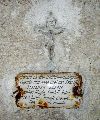The Sacconi Rossi Brotherhood
Article Index
A) History and Description
B) Movies and images
C) Bibliography and references
![]()
A) HISTORY AND DESCRIPTION
The venerable "Brotherhood of the Devotees of Jesus at Calvary and Holy Lady Mary of Sorrows in relief of the Holy Souls in Purgatory ", this is the full name, commonly known as "Brotherhood of the Sacconi Rossi” [Big Red Sacks], was established in 1760 on the initiative of some young people who founded an association for daily practice of the Cross to "meditate on the atrocious passion of the Redeemer" and then benefit "the souls suffering in the in Purgatory prison." During the performance of their duties they ahd on a red hooded cape hence came the popular name Sacconi Rossi with which they are commonly known.
The main task of the Brotherhood was to support the deceased, to bury the abandoned dead bodies and in particular to collect and bury the dead people drowned in the Tiber, if nobody had claimed them; these duties were carried out in the night in torchlight processions.
The Brotherhood was at first accommodated (1768) by the Minor Franciscans Friars of the Basilica of St. Bartholomew on Tiber Island and later (1780) obtained by the Minor Friars to buy the three naves room, formerly used as a warehouse, located on the ground floor of the left wing of the Convent to rearrange it as an oratory. In 1784 it got acknowledgement by Pope Pius VI (1775-1799) and the permission to build a crypt-cemetery in the basement beneath the oratory to bury their deceased brothers. Similar to the Crypt of the Cappuccini at Via Veneto, also the Sacconi Rossi used the bones of the dead brothers to decorate the walls and the niches of the crypt-cemetery (still visible). These matters has been shown in the controversial Italian movie-documentary "Mondo Cane" in 1962 (see next point B).
The cemetery, nearly become a charnel house, was an unhealthy place also because of the Tiber floods and it was regularly used until 1836 when, due to epidemic cholera spread in the city and in most part of Italy, Pope Gregory XVI (1831-1846) decreed that the burials take place solely at Verano cemetery.
The abolition of this privilege marked the decadence of the Brotherhood who suffered a further shock during the repression of the Roman Republic (1849) by French troops who, re-entering to Rome, occupied the premises of the Brotherhood sacking and transforming them into a dormitory. In 1851 the few remaining devotees took back the possession of the oratory giving a new vitality to the Brotherhood also thanks to the permission of Pope Pius IX (1846-1878) to resume burials in the underground cemetery.
After the capture of Rome by the Kingdom of Italy (September 20th 1870) the Royal Decree No 5991 of November 6th 1870 extended to the province of Rome the Regulation of Health of the Kingdom, consequently on 25 February 25th 1871 all cemeteries in hospitals, convents and similar, including the Sacconi Rossi’s one, were permanently closed. It was a serious shock for the Brotherhood that lost its main raison d'etre; the Brotherhood gradually lost many of its members and around 1960 came almost to extinction.
Since 1983, the Venerable Brotherhood of Santa Maria dell’Orto individually recovered the inheritance of the Sacconi Rossi restoring the custom of commemorating the dead in the Tiber river through a ceremony on the banks of the Tiber island. Recently, the commemoration has been extended to all the nameless dead perished in natural disasters and in war.
In 1988 the Fatebenefratelli Hospital Order got the availability of the rooms previously belonged to the Brotherhood, moving there the nurse school of the Hospital, and in December 1989 the Prior Anselmo Petrillo signed an agreement with the Vicariate stating that the Prior of the Hospital and each brother of its community were henceforth recognized as members of the Brotherhood, in order to ensure its continuity. The existence of the Brotherhood is therefore now assured by the Prior of the Fatebenefratelli Hospital, which took the control of the Oratory of the Sacconi Rossi.
After the re-forming of the "Sacconi Rossi”, every November 2nd, at sunset, a Mass is celebrated in the church of St. John Calibita followed by a candlelight procession along the banks of the Island led by the Brotherhood of Santa Maria dell’Orto which ends at the island tip opposite Ponte Rotto with the launch of a wreath into the Tiber as a tribute to the dead.
B) MOVIES ABD IMAGES
The trailer here shown is available on the web and therefore it is considered of public domain
From: Mondo Cane (Paolo Cavara, Gualtiero Jacopetti and Franco Prosperi) - 1962
The link on the title displays in a new window more information about the movie from the website www.imdb.com (Internet Movie DataBase)
Trailer Length: 1'49"
C) BIBLIOGRAPHY AND REFERENCES
1- The island of the hospitals: the Fatebenefratelli - Part II - Link
2- SPQR - The site of papal Rome - Link
3- Venerable Brotherhood of Santa Maria dell’Orto [St. Mary of the Garden] - Link
4- Bro Joseph Magliozzi - Il Melograno Year XII, No. 22 - Manila, June 30th 2010











